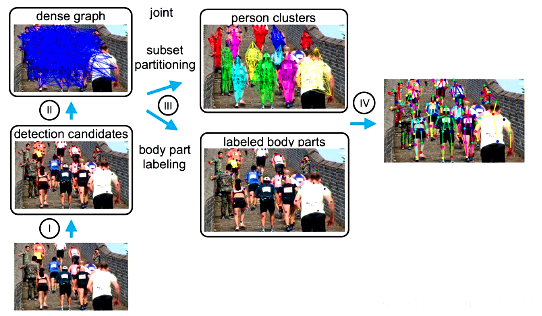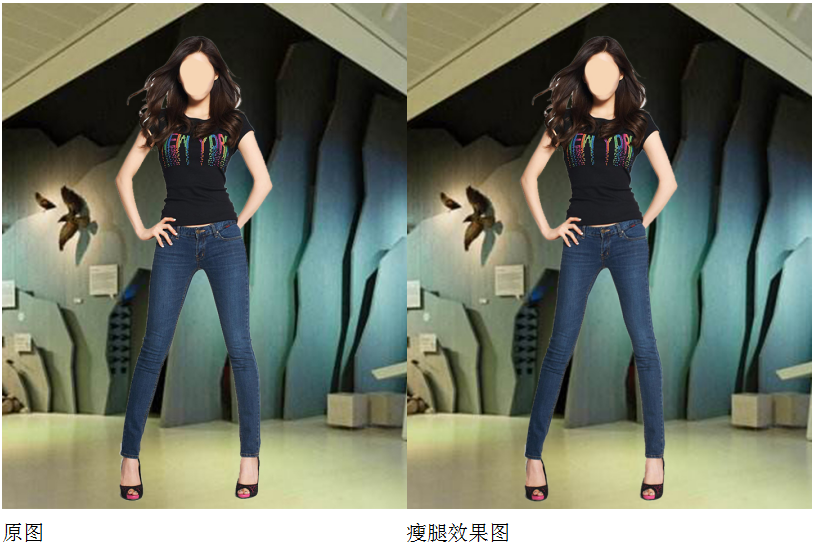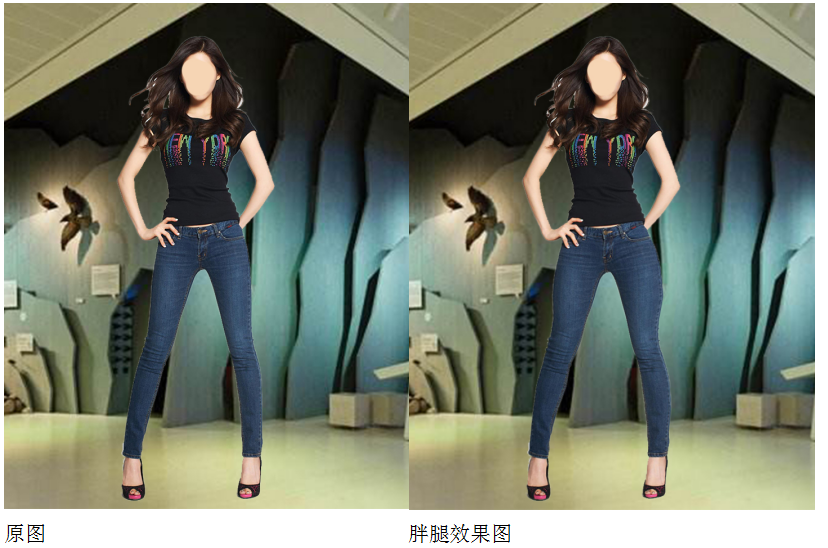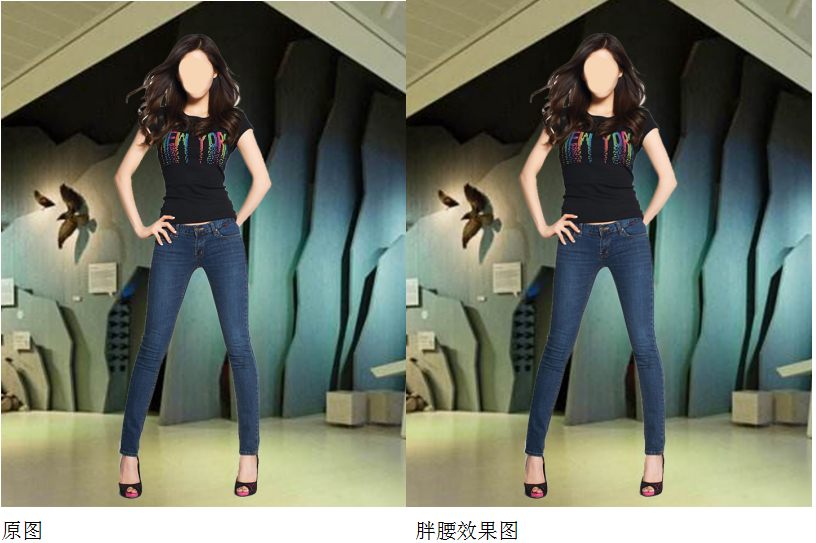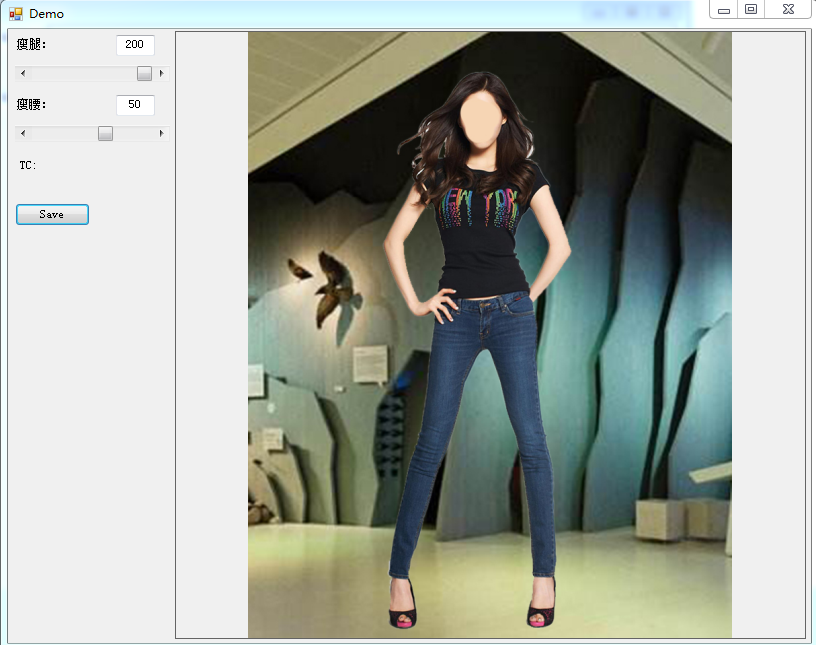深度學習AI美顏系列---AI瘦身效果演算法揭祕
最近一段時間,抖音、微視、美圖紛紛推出了視訊實時瘦身的特效,可以說是火了一把!本文將給大家做個技術揭祕!
商湯基於深度學習研發了整套瘦身SDK,包括了瘦腿,瘦腰,瘦胳膊,瘦頭型等等功能,並給出了酷炫的實時瘦身視訊,驚豔到了眾人!本文將以瘦腰和瘦腿為例,給大家詳細講解一下。
瘦身從演算法角度來講,包含兩個模組:①人體輪廓特徵點檢測模組;②人體變形模組
[人體輪廓特徵點檢測模組]
人體輪廓特徵點檢測模組好比人臉特徵點檢測,需要檢測到代表人體輪廓的一些點位資訊,但是技術上比人臉特徵點更加複雜,因為人體是非剛體,比人臉的變化更多,更復雜;
目前人體輪廓特徵點檢測主要方法就是人體姿態估計;從2015年開始,陸續出現了很多人體姿態估計的論文,這裡舉例如:
DeeperCut: A Deeper, Stronger, and Faster Multi-Person Pose Estimation Model
這篇論文中所提供的深度學習模型與效果圖如下:
這裡我們不詳細介紹人體姿態估計的演算法,主要以講瘦身的流程為主;
上面的姿態點與我們想要的輪廓點還有差別,在掌握了上面的人體姿態估計演算法之後,我們可以使用人體輪廓點的樣本進行訓練,這樣就可以得到如下圖所示的人體輪廓特徵點:
圖片來自網路,為了避免侵權,做了人臉遮擋;
[人體變形模組]
人體變形模組主要是依據人體特徵點,將人體變形,也就是瘦身美型;
變形的演算法有很多,比如MLS移動最小二乘法變形演算法,IWD反距離加權變形演算法,MLSR變形演算法等等,相關連線如下:
MLSR變形演算法實現:點選開啟連結
IWD反距離加權變形演算法實現:點選開啟連結
MLS移動最小二乘變形演算法實現:點選開啟連結,程式碼連結點選開啟連結
本人MLS程式碼如下:
static void setSrcPoints(const vector<PointD> &qsrc, vector<PointD> &newDotL, int* nPoint) { *nPoint = qsrc.size(); newDotL.clear(); newDotL.reserve(*nPoint); for (size_t i = 0; i < qsrc.size(); i++) newDotL.push_back(qsrc[i]); } static void setDstPoints(const vector<PointD> &qdst,vector<PointD> &oldDotL, int* nPoint) { *nPoint = qdst.size(); oldDotL.clear(); oldDotL.reserve(*nPoint); for (size_t i = 0; i < qdst.size(); i++) oldDotL.push_back(qdst[i]); } static double bilinear_interp(double x, double y, double v11, double v12, double v21, double v22) { return (v11 * (1 - y) + v12 * y) * (1 - x) + (v21 * (1 - y) + v22 * y) * x; } static double calcArea(const vector<PointD> &V) { PointD lt, rb; lt.x = lt.y = 1e10; rb.x = rb.y = -1e10; for (vector<PointD >::const_iterator i = V.begin(); i != V.end(); i++) { if (i->x < lt.x) lt.x = i->x; if (i->x > rb.x) rb.x = i->x; if (i->y < lt.y) lt.y = i->y; if (i->y > rb.y) rb.y = i->y; } return (rb.x - lt.x) * (rb.y - lt.y); } static void calcDelta_rigid(int srcW, int srcH, int tarW, int tarH, double alpha, int gridSize, int nPoint, int preScale, double *rDx, double *rDy, vector<PointD> &oldDotL, vector<PointD> &newDotL) { int i, j, k; PointD swq, qstar, newP, tmpP; double sw; double ratio; if (preScale) { ratio = sqrt(calcArea(newDotL) / calcArea(oldDotL)); for (i = 0; i < nPoint; i++) { newDotL[i].x *= 1 / ratio; newDotL[i].y *= 1 / ratio; } } double *w = new double[nPoint]; if (nPoint < 2) { //rDx.setTo(0); //rDy.setTo(0); return; } PointD swp, pstar, curV, curVJ, Pi, PiJ, Qi; double miu_r; for (i = 0;; i += gridSize) { if (i >= tarW && i < tarW + gridSize - 1) i = tarW - 1; else if (i >= tarW) break; for (j = 0;; j += gridSize) { if (j >= tarH && j < tarH + gridSize - 1) j = tarH - 1; else if (j >= tarH) break; sw = 0; swp.x = swp.y = 0; swq.x = swq.y = 0; newP.x = newP.y = 0; curV.x = i; curV.y = j; for (k = 0; k < nPoint; k++) { if ((i == oldDotL[k].x) && j == oldDotL[k].y) break; if (alpha == 1) w[k] = 1 / ((i - oldDotL[k].x) * (i - oldDotL[k].x) + (j - oldDotL[k].y) * (j - oldDotL[k].y)); else w[k] = pow((i - oldDotL[k].x) * (i - oldDotL[k].x) + (j - oldDotL[k].y) * (j - oldDotL[k].y), -alpha); sw = sw + w[k]; swp.x = swp.x + w[k] * oldDotL[k].x; swp.y = swp.y + w[k] * oldDotL[k].y; swq.x = swq.x + w[k] * newDotL[k].x; swq.y = swq.y + w[k] * newDotL[k].y; } if (k == nPoint) { pstar.x = (1 / sw) * swp.x; pstar.y = (1 / sw) * swp.y; qstar.x = 1 / sw * swq.x; qstar.y = 1 / sw * swq.y; // Calc miu_r double s1 = 0, s2 = 0; for (k = 0; k < nPoint; k++) { if (i == oldDotL[k].x && j == oldDotL[k].y) continue; Pi.x = oldDotL[k].x - pstar.x; Pi.y = oldDotL[k].y - pstar.y; PiJ.x = -Pi.y, PiJ.y = Pi.x; Qi.x = newDotL[k].x - qstar.x; Qi.y = newDotL[k].y - qstar.y; s1 += w[k] * (Qi.x*Pi.x+Qi.y*Pi.y); s2 += w[k] * (Qi.x*PiJ.x+Qi.y*PiJ.y); } miu_r = sqrt(s1 * s1 + s2 * s2); curV.x -= pstar.x; curV.y -= pstar.y; curVJ.x = -curV.y, curVJ.y = curV.x; for (k = 0; k < nPoint; k++) { if (i == oldDotL[k].x && j == oldDotL[k].y) continue; Pi.x = oldDotL[k].x - pstar.x; Pi.y = oldDotL[k].y - pstar.y; PiJ.x = -Pi.y, PiJ.y = Pi.x; tmpP.x = (Pi.x*curV.x+Pi.y*curV.y)* newDotL[k].x - (PiJ.x*curV.x+PiJ.y*curV.y)* newDotL[k].y; tmpP.y = -(Pi.x*curVJ.x+Pi.y*curVJ.y) * newDotL[k].x + (PiJ.x*curVJ.x+PiJ.y*curVJ.y) * newDotL[k].y; tmpP.x *= w[k] / miu_r; tmpP.y *= w[k] / miu_r; newP.x += tmpP.x; newP.y += tmpP.y; } newP.x += qstar.x; newP.y += qstar.y; } else { newP = newDotL[k]; } if (preScale) { rDx[j * tarW + i] = newP.x * ratio - i; rDy[j * tarW + i] = newP.y * ratio - j; } else { rDx[j * tarW + i] = newP.x - i; rDy[j * tarW + i] = newP.y - j; } } } delete[] w; if (preScale!=0) { for (i = 0; i < nPoint; i++){ newDotL[i].x *= ratio; newDotL[i].y *= ratio; } } } static void calcDelta_Similarity(int srcW, int srcH, int tarW, int tarH, double alpha, int gridSize, int nPoint, int preScale, double *rDx, double *rDy, vector<PointD> &oldDotL, vector<PointD> &newDotL) { int i, j, k; PointD swq, qstar, newP, tmpP; double sw; double ratio; if (preScale) { ratio = sqrt(calcArea(newDotL) / calcArea(oldDotL)); for (i = 0; i < nPoint; i++) { newDotL[i].x *= 1 / ratio; newDotL[i].y *= 1 / ratio; } } double *w = new double[nPoint]; if (nPoint < 2) { return; } PointD swp, pstar, curV, curVJ, Pi, PiJ; double miu_s; for (i = 0;; i += gridSize) { if (i >= tarW && i < tarW + gridSize - 1) i = tarW - 1; else if (i >= tarW) break; for (j = 0;; j += gridSize) { if (j >= tarH && j < tarH + gridSize - 1) j = tarH - 1; else if (j >= tarH) break; sw = 0; swp.x = swp.y = 0; swq.x = swq.y = 0; newP.x = newP.y = 0; curV.x = i; curV.y = j; for (k = 0; k < nPoint; k++) { if ((i == oldDotL[k].x) && j == oldDotL[k].y) break; w[k] = 1 / ((i - oldDotL[k].x) * (i - oldDotL[k].x) + (j - oldDotL[k].y) * (j - oldDotL[k].y)); sw = sw + w[k]; swp.x = swp.x + w[k] * oldDotL[k].x; swp.y = swp.y + w[k] * oldDotL[k].y; swq.x = swq.x + w[k] * newDotL[k].x; swq.y = swq.y + w[k] * newDotL[k].y; } if (k == nPoint) { pstar.x = (1 / sw) * swp.x; pstar.y = (1 / sw) * swp.y; qstar.x = 1 / sw * swq.x; qstar.y = 1 / sw * swq.y; // Calc miu_s miu_s = 0; for (k = 0; k < nPoint; k++) { if (i == oldDotL[k].x && j == oldDotL[k].y) continue; Pi.x = oldDotL[k].x - pstar.x; Pi.y = oldDotL[k].y - pstar.y; miu_s += w[k] * (Pi.x*Pi.x+Pi.y*Pi.y); } curV.x -= pstar.x; curV.y -= pstar.y; curVJ.x = -curV.y, curVJ.y = curV.x; for (k = 0; k < nPoint; k++) { if (i == oldDotL[k].x && j == oldDotL[k].y) continue; Pi.x = oldDotL[k].x - pstar.x; Pi.y = oldDotL[k].y - pstar.y; PiJ.x = -Pi.y, PiJ.y = Pi.x; tmpP.x = (Pi.x*curV.x+Pi.y*curV.y) * newDotL[k].x - (PiJ.x*curV.x+PiJ.y*curV.y) * newDotL[k].y; tmpP.y = -(Pi.x*curVJ.x+Pi.y*curVJ.y) * newDotL[k].x + (PiJ.x*curVJ.x+PiJ.y*curVJ.y) * newDotL[k].y; tmpP.x *= w[k] / miu_s; tmpP.y *= w[k] / miu_s; newP.x += tmpP.x; newP.y += tmpP.y; } newP.x += qstar.x; newP.y += qstar.y; } else { newP = newDotL[k]; } rDx[j * tarW + i] = newP.x - i; rDy[j * tarW + i] = newP.y - j; } } delete[] w; if (preScale!=0) { for (i = 0; i < nPoint; i++){ newDotL[i].x *= ratio; newDotL[i].y *= ratio; } } } static int GetNewImg(unsigned char* oriImg, int width, int height, int stride, unsigned char* tarImg, int tarW, int tarH, int tarStride, int gridSize, double* rDx, double* rDy, double transRatio) { int i, j; double di, dj; double nx, ny; int nxi, nyi, nxi1, nyi1; double deltaX, deltaY; double w, h; int ni, nj; int pos, posa, posb, posc, posd; for (i = 0; i < tarH; i += gridSize) for (j = 0; j < tarW; j += gridSize) { ni = i + gridSize, nj = j + gridSize; w = h = gridSize; if (ni >= tarH) ni = tarH - 1, h = ni - i + 1; if (nj >= tarW) nj = tarW - 1, w = nj - j + 1; for (di = 0; di < h; di++) for (dj = 0; dj < w; dj++) { deltaX = bilinear_interp(di / h, dj / w, rDx[i * tarW + j], rDx[i * tarW + nj], rDx[ni * tarW + j], rDx[ni * tarW + nj]); deltaY = bilinear_interp(di / h, dj / w, rDy[i * tarW + j], rDy[i * tarW + nj], rDy[ni * tarW + j], rDy[ni * tarW + nj]); nx = j + dj + deltaX * transRatio; ny = i + di + deltaY * transRatio; if (nx > width - 1) nx = width - 1; if (ny > height - 1) ny = height - 1; if (nx < 0) nx = 0; if (ny < 0) ny = 0; nxi = int(nx); nyi = int(ny); nxi1 = ceil(nx); nyi1 = ceil(ny); pos = (int)(i + di) * tarStride + ((int)(j + dj) << 2); posa = nyi * stride + (nxi << 2); posb = nyi * stride + (nxi1 << 2); posc = nyi1 * stride + (nxi << 2); posd = nyi1 * stride + (nxi1 << 2); tarImg[pos] = (unsigned char)bilinear_interp(ny - nyi, nx - nxi, oriImg[posa], oriImg[posb], oriImg[posc], oriImg[posd]); tarImg[pos + 1] = (unsigned char)bilinear_interp(ny - nyi, nx - nxi, oriImg[posa + 1],oriImg[posb + 1], oriImg[posc + 1], oriImg[posd + 1]); tarImg[pos + 2] = (unsigned char)bilinear_interp(ny - nyi, nx - nxi, oriImg[posa + 2],oriImg[posb + 2], oriImg[posc + 2], oriImg[posd + 2]); tarImg[pos + 3] = (unsigned char)bilinear_interp(ny - nyi, nx - nxi, oriImg[posa + 3],oriImg[posb + 3], oriImg[posc + 3], oriImg[posd + 3]); } } return 0; }; static void MLSImageWrapping(unsigned char* oriImg,int width, int height, int stride,const vector<PointD > &qsrc, const vector<PointD > &qdst, unsigned char* tarImg, int outW, int outH, int outStride, double transRatio, int preScale, int gridSize, int method) { int srcW = width; int srcH = height; int tarW = outW; int tarH = outH; double alpha = 1; int nPoint; int len = tarH * tarW; vector<PointD> oldDotL, newDotL; double *rDx = NULL,*rDy = NULL; setSrcPoints(qsrc,newDotL,&nPoint); setDstPoints(qdst,oldDotL,&nPoint); rDx = (double*)malloc(sizeof(double) * len); rDy = (double*)malloc(sizeof(double) * len); memset(rDx, 0, sizeof(double) * len); memset(rDy, 0, sizeof(double) * len); if(method!=0) calcDelta_Similarity(srcW, srcH, tarW, tarH, alpha, gridSize, nPoint, preScale, rDx, rDy, oldDotL, newDotL); else calcDelta_rigid(srcW, srcH, tarW, tarH, alpha, gridSize, nPoint, preScale, rDx, rDy, oldDotL, newDotL); GetNewImg(oriImg, srcW, srcH, stride, tarImg, tarW, tarH, outStride, gridSize, rDx, rDy, transRatio); if(rDx != NULL) free(rDx); if(rDy != NULL) free(rDy); }; int f_TMLSImagewarpping(unsigned char* srcData, int width ,int height, int stride, unsigned char* dstData, int outW, int outH, int outStride, int srcPoint[], int dragPoint[], int pointNum, double intensity, int preScale, int gridSize, int method) { int res = 0; vector<PointD> qDst; vector<PointD> qSrc; PointD point = {0}; int len = 0; for(int i = 0; i < pointNum; i++) { len = (i << 1); point.x = srcPoint[len]; point.y = srcPoint[len + 1]; qSrc.push_back(point); point.x = dragPoint[len]; point.y = dragPoint[len + 1]; qDst.push_back(point); } MLSImageWrapping(srcData, width, height, stride, qSrc, qDst, dstData, outW, outH, outStride, intensity, preScale,gridSize, method); return res; };
本人這裡使用MLS變形來實現瘦身效果:
1,根據人體姿態估計檢測得到原圖人體的特徵點;
2,計算得到瘦腿之後的人體特徵點;
3,計算得到瘦腰之後的人體特徵點;
1-3如下圖所示:
4,使用MLS,將原圖特徵點分別變換到瘦腿特徵點和瘦腰特徵點,進而得到兩個相應的效果圖如下(這裡給出四個效果):
至此,瘦身效果的演算法流程講完,至於實時處理,那是程式碼優化和演算法優化的事情,只要速度夠快,一切都不是問題!
上面只是以瘦腿和瘦腰為例,實際上還可以瘦胳膊,豐胸等等,來真正的達到美顏瘦身!
本人的DEMO介面如下:
本人QQ1358009172
最後給出本人的DEMO:點選開啟連結

